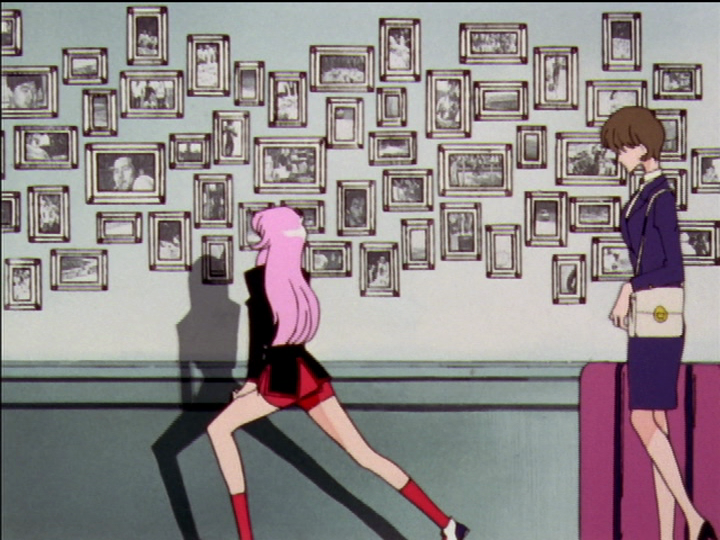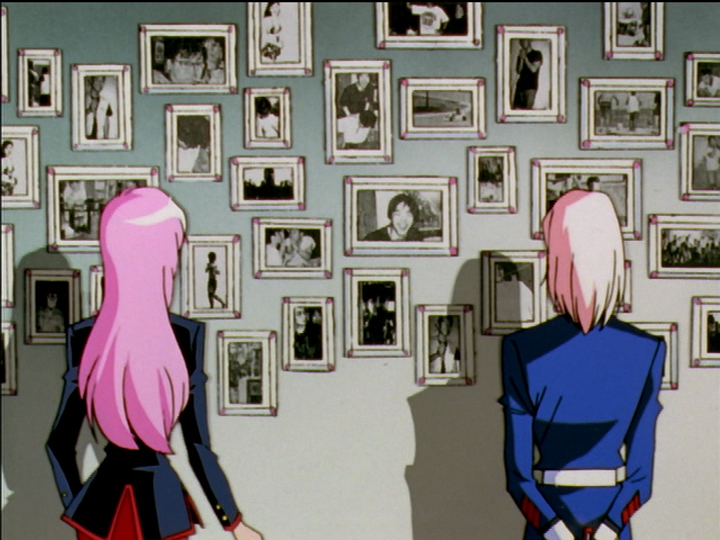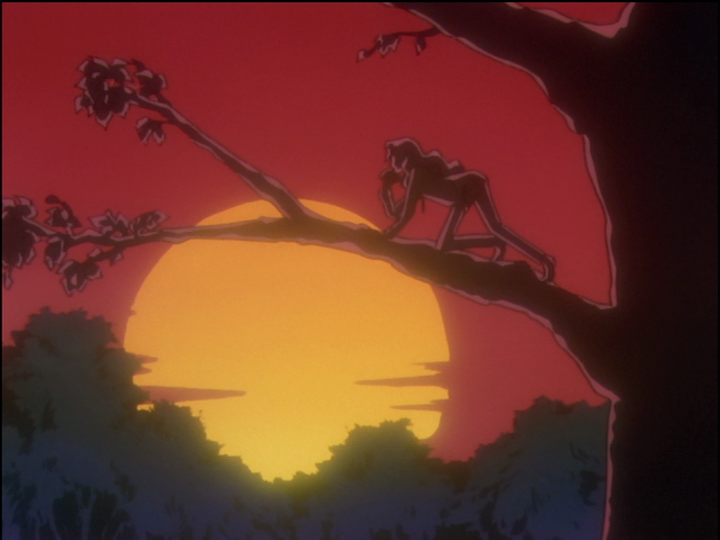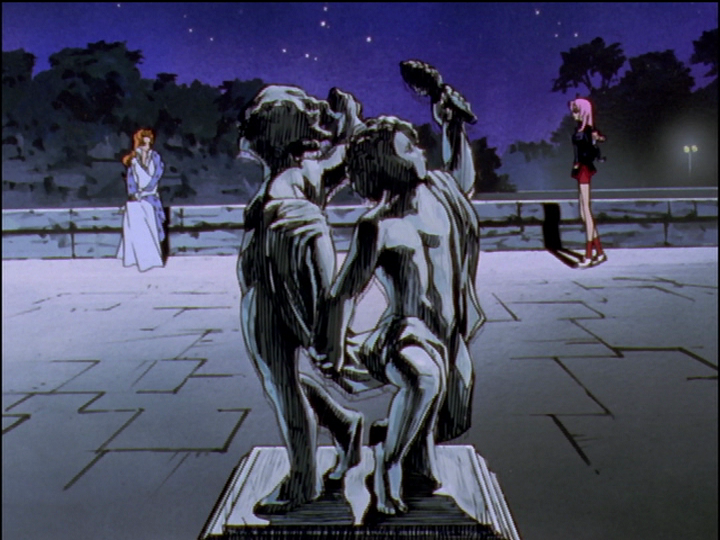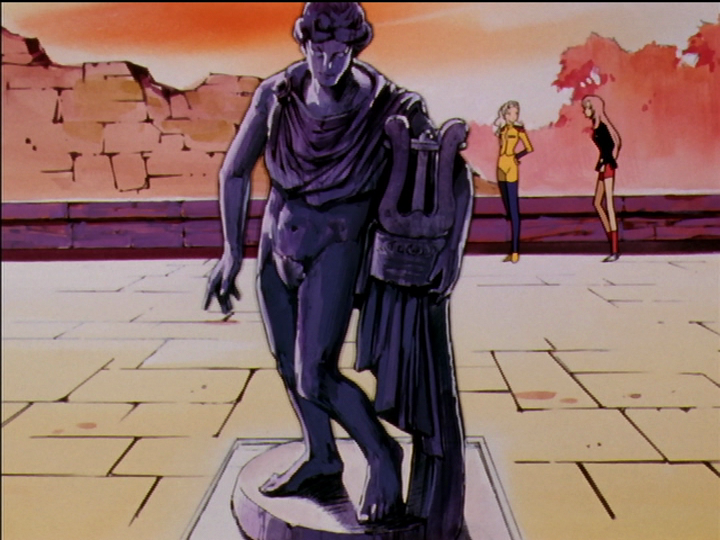Utena - art references
A number of these are unidentified, and have resisted my efforts so far.
Many, many images in Utena could be art references. Or not. Even if many are, I’m not likely to recognize them. So far, I randomly ran across one reference, rare luck. I’ll take suggestions.
films and photographs
One way Mikage seeks eternity is with a wall of photos, each eternalizing a moment. His photos show the Black Rose duelists and the like, including little Utena at her parents’ funeral.
But only in close views! When seen from a distance, the pictures are two sets of seeming real-world photos, one set earlier with Tokiko passing by, the other later after Mikage has arrived. I can’t identify any of them. I have no idea what it may mean. In the second set I notice two pairs, where the same photo is cropped differently.
Even on a fuzzy 1997 TV, it should be possible to tell that the close views and distant views are different. The layouts of the distant views match, though the photos are different.
See mysteries - split screen. This split-screen view of outside and inside is surely a film reference. I can’t identify it. To me it feels like a later silent film, but that is only a guess.
paintings
Olympia
The image is obviously a reference. I found the right search keywords to give me the source: The painting Olympia (Wikipedia) by Édouard Manet, from 1865. Apparently it’s famous among people who it’s famous among, if you know what I mean. The painting is of a high-class prostitute in bed, named Olympia, looking toward the viewer. A servant has brought flowers, no doubt from a customer—likely the one Olympia is looking at. The servant looks at Olympia, as if reading her intentions to decide what to do with the flowers. The black and white colors I take to represent good and evil: Olympia is a sought-after perceived good, and a sinful evil. At least, that’s an interpretation that makes it fit nicely with Utena. It is like Akio tempting Utena to take his evil as good.
The use of gaze reminds me of the First Seduction, where the camera shows Akio’s point of view. The hotel scene puts the audience in Akio’s place, so that we ourselves wordlessly seduce and rape Utena. In Olympia the camera puts the audience in the place of the john. The painting and the First Seduction tell different versions of the same story: All of us participate in social evils, because all of us participate in the cultural processes that enable social evils. That’s what it means to me.
I have a harder time interpreting the image in the context of episode 23. Mikage is resting and discussing the duelist boys and eternity with Mamiya. It’s just before Mikage burns his building, killing the boys. Mamiya is cast as the servant with the flowers; they are roses, and he holds them higher and higher through the conversation until they cover his face. Mamiya is a servant, but not Mikage’s servant: Mamiya is controlling Mikage under Akio’s orders. Mikage has a contract with Akio and insists that it is just business, so I guess he is prostituting himself to Akio. I don’t understand it yet.
The Nightmare
On the right is “The Nightmare” (Wikimedia), a 1781 painting by Henry Fuseli. See The Nightmare on Wikipedia for more. Wikimedia oddly ties it to a Creative Commons license though the painting is obviously in the public domain, and their standard policy is that a faithful copy of a public domain work is in the public domain.
In the Student Council and Black Rose arcs, drawing the sword from Anthy is a sexualized expression of power over her. It’s standard Utena stuff, and on the face of it there’s no reason to expect more—the Utena image is not obviously a reference. But Anthy is in a nightmare, and the painting has striking similarities. Both images indicate sexual exploitation of a powerless woman. Utena’s closed eyes echo the nightmare demon’s (an incubus). After drawing the sword Utena opens her eyes, and Anthy’s reflection in the sword shows that hers are still closed. Utena’s floating hair can correspond to the painting’s background curtain. It happens in Akio’s darkness. It’s the same for Saionji in episode 1 and Touga in episode 12. The left-to-right reversal is common in Utena image references. Anthy’s head on the left says that her suffering is an illusion, a Buddhist belief.
So in the Student Council arc, the one drawing Anthy’s sword is an incubus and/or succubus. But... drawing a sword in the Black Rose is worse yet.
The horse poking out from behind the curtain is a literal night mare: The prince’s horse is a nightmare. Utena brings patriarchal power and reinforces Anthy’s bad dream of the prince.
Here is a painting with a related theme: The dream of Countess Marguerite of Flanders (Wikimedia). It depicts an incubus with a dagger to correspond to the sword. The dagger shares the meaning of sexual power.
traditional Japanese art
Chu-Chu as Saionji. The image is in the style of traditional Japanese art, to go with Saionji, the character most aligned with Japanese tradition. (I suspect because he watched too many samurai movies; see Saionji’s television world.) Traditionally the sun would be red and the sky light, but except for that and the gag of Chu-Chu dropping a banana peel, all aspects look traditional to me. The sun with streaks of cloud at the edges, background landscape, and foreground tree silhouette are tropes of traditional Japanese art.
The banana peel is metaphorically for Saionji to slip on. It’s like other banana peels.
It’s possible that it parodies a specific original, but I haven’t found one. I looked at a bunch of sumi-e ink paintings and ukiyo-e woodblock prints.
unidentified painting
The fruit basket is a close-up of the fruit on the long banquet table shortly before Mikage burns down his building. It seems like an old painting with a meaning. It looks sensuous and may go with Olympia.
I tried a bunch of image searches, including reverse image searches, and could not turn it up. It seemed strange, because this is a strong image, in my eyes superior to most of the famous still life paintings that I did turn up. It ought to be well known. If it is original to Utena—I’m impressed. And surprised, because it sure looks like a reference.
fuzzy pictures
The ones that are not depicted clearly are probably not very important. There are a lot more beyond these examples.
The painting on the right is a Dutch windmill painting. You can tell by the X shape. We can’t see much, but I felt there might be enough detail to identify an original. I looked through a large number of Dutch windmill paintings, and did not find one that I thought matched.
Possibly it is supposed to be a generic windmill painting, and does not have an original. I think that being unable to find any match validated my feeling that there is enough detail to recognize an original if I saw one. If I saw multiple possible matches, I would know there wasn’t enough to go on.
The painting on the wall is hard to make out. At DVD resolution, I could not parse it. On a 1997 television, it must have been impossible. In a closer look, it turns into a fuzzy-edged flower arrangement. I’m still not sure what kind of flowers they are. Some blossoms resemble faces.
The episode is Nanami’s Egg. The red of the walls and painting is surely meaningful.
sculptures
In episode 3, we see the Kiryuu mansion with its square pond in front. A large sculpture sits in the middle of the pond. The image is clear enough to match it with an original if I can find one.
I suspect it may be a mermaid sculpture. Anthy is the Little Mermaid, who dances with the prince, and Anthy dances with prince Utena in the episode. The dance is an early step in Utena saving Anthy. It would make sense if the sculpture depicts the Little Mermaid saving the prince, to represent Anthy saving Utena as they work together. There are other ways it could make sense.
So far, the most similar sculptures I have found are in the 18th century fountains at Schönbrunn Palace in Vienna, especially the two in the Ehrenhof. None is a match, but they have a similar feel. If there is an original, it may belong to the same neoclassical tradition.
Utena is entering the sculpture garden. The sculptures are more abstract than representational. The tall one refers to the rabbit-duck (Wikipedia) ambiguous figure. In episode 7, the sculptures are rounded in shape (girlish) and are followed by the man with a deer (immediately below). The night image repeats in episode 16, the cowbell. In episode 31, the sculptures are sharp-edged (boyish for Utena) and followed by images of couples.
By night with the moon, blue and more rabbit. By day, orange and more duck. The shadow play of episode 31 is an ugly duckling story. The sculpture ties the ugly duckling to the rabbit in the moon. For the episode, Nanami and Utena are cuckoos and are failing due to one-sided love. For the story, Utena and Anthy are both the rabbit in the moon, and when they leave the Academy, they turn adult and miraculously become beautiful swans. Orange means one-sided love and miracles.
Utena is on her way home at night, unknowingly heading toward an encounter with Juri. The man and deer sculpture show while she is trying to calm Chu-Chu; the man seems to be calming the deer.
Possibly the deer is the one provided by Artemis in the myth of the sacrifice of princess Iphigenia (Wikipedia). Artemis in some versions substituted the deer and saved Iphigenia. Just a bit of unfounded speculation. I tried Hercules’ infant son Telephus, who was suckled by a deer, but no luck. I didn’t find any other myths that seem relevant (no golden antlers here).
The woman sculpture seems to refer to Utena’s upcoming meeting with Juri in episode 7, and Nanami in episode 31.
The sculpture has both arms, but resembles the Venus de Milo (Wikipedia). It’s not very close. Instead, the angle of her head and positions of her arms suggest she might be the Aphrodite of Knidos (Wikipedia) before she took off her... whatever that clothing is called. If it is Aphrodite, then maybe it points out that love comes up in both meetings (Juri stroking Utena’s arm; Nanami establishing that Utena likes Akio). Aphrodite’s planet is Venus, which is Akio named himself after.
The sculpture of siblings repeats in episodes 7 and 31. Its pedestal changes in between, and so does its background. The dark trees and the daylight wall match closely, but at the same time they are very different. It is likely significant that the sculpture is lit at night, but shadowed in the day. I don’t know why the sculpture appears in episode 7, but in episode 31 we see it when Nanami and Utena are discussing siblings. This one seems especially important to identify. They may be holding the symbolic attributes of gods. I tried fairly hard, but no luck so far. Among others, I tried to match it to twins Castor and Pollux, and the twins Apollo and Artemis.
They’re carrying three identical Roman busts for art class, and claiming through their glasses that that’s who they are. It is the bust of Brutus sculpted by Michaelangelo (Wikipedia). The turned head, folds of the toga, and shape of the undefined ears line up. Based on Wikipedia’s information about the bust, the nerd boys are claiming to be heroic rebels against tyranny—Brutus was one of the assassins of Julius Caesar.
The toga is a pun on Touga. The nerd boys want Nanami, and probably consider that Touga is monopolizing her attention. The three are stuck on the stairs between Nanami and Utena (an actual heroic rebel against tyranny), who are arguing past them about Touga. Immediately after, Akio demonstrates his tyranny, rescuing Nanami from the accident he arranged. The three replica sculptures fall and break; the nerd boys are impressed by Akio too.
It’s a sculpture of Apollo with his lyre, and is taken from Mishima Yukio’s House. When it appears, Nanami has just said that any little sister would fall for a brother like that, and Utena replies that Nanami is the only one. It’s true as far as Utena knows—but Utena does not know very far. See siblings and incest. It hints that Nanami has fallen for Akio. The first hint was her blush and enraptured expression when Akio rescued her on the stairs earlier in the episode.
I guess novelist Mishima would have seen Apollo as a god of poetry and art. In this case though, I think Apollo is the god of truth, and a sun god, so the statue refers to Dios. Stepping back for a wider view, you could say it’s about telling truth through fiction, as Utena does.
This is the sculpture The Rape of Proserpina (Wikipedia) by Gian Lorenzo Bernini, which depicts Pluto kidnapping Proserpina, taking her to the underworld to be his wife. Pluto and Proserpina (commonly Proserpine in English) are the Latin names corresponding to the Greek Hades and Persephone. In Utena they match up with Mikage (ruler of the underworld) and Mamiya as played by Anthy (his “wife” and stand-in for Tokiko). It’s hard to see in the image, but in the original sculpture Pluto wears a crown that is strikingly similar to an Utena princess crown. Mikage is under Akio’s control and is effectively a princess.
Nanami and Utena are discussing Akio. In context, it seems to mean that Akio will abduct Utena and carry her to his underworld to be his wife. It’s not far from what happens: His tower room is metaphorically underground. Akio abducts Utena to a hotel and lies that they will marry and live happily ever after in the castle in the sky. And Akio is, of course, a princess. Before that, though, he gives Nanami the same treatment.
